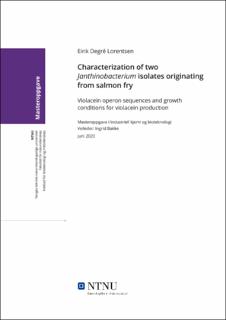| dc.contributor.advisor | Bakke, Ingrid | |
| dc.contributor.author | Lorentsen, Eirik Degré | |
| dc.date.accessioned | 2021-09-25T16:09:07Z | |
| dc.date.available | 2021-09-25T16:09:07Z | |
| dc.date.issued | 2020 | |
| dc.identifier | no.ntnu:inspera:56744382:36757885 | |
| dc.identifier.uri | https://hdl.handle.net/11250/2782564 | |
| dc.description.abstract | Bakteriestammene som det ble jobbet med i dette prosjektet (MM5 og 3.116) var isolert fra skinnet til lakseyngel og ble klassifisert som Janthinobacterium (Betaproteobacteria, Oxalobacteraceae). Under tidligere arbeid i Analyse og kontroll av mikrobielle samfunn (ACMS) gruppen ved Norges teknisk-naturvitenskapelige universitet (NTNU) med disse stammene har det blitt observert produksjon av slim og lilla kolonier antatt til å være EPS og violacein. J. Lividum assosieres med både menneske- og amfibiehud, og er antatt å være en del av amfibienes forsvar mot soppinfeksjoner i huden. De antifungale egenskapene til J. Lividum er assosiert med det lilla fargestoffet violacein, som i tillegg har vist blant annet antibakterielle, antioksiderende, antivirale og antitumorale egenskaper. Bakterietypen har vist kapnofile egenskaper, noe som gir evnen til å leve på de forhøyede CO2 konsentrasjonene som finnes på amfibiehud. Disse nevnte egenskapene gjør bakterien til en interessant kandidat som probiotika i oppdrettsnæringen, for eksempel som en metode for å bekjempe eggsporesoppen Saprolegnia, som kan være et problem i ferskvannstadiene av laksens livssyklus.
Hovedmålene med dette prosjektet var å identifisere vekstforhold som promoterer violacein produksjon i MM5 og 3.116, og å studere evolusjonen av violacein operonet ved fylogenetiske analyser. Veksten til stammene ble studert ved å lage vekstkurver, antibiogramer og mikroskopering. Generasjonstiden til MM5 og 3.116 ble beregnet til å være henholdsvis 1.5 og 0.88 timer. En test av mottakelighet for antibiotika, viste resistens mot kanamycin (50 µg/ml), polymixin (100 µg/ml), neomycin (20 µg/ml), og ampicillin (20 µg/ml) for begge stammene. MM5 viste lilla kolonier, som indikerer violacein produksjon på flere mediumer. Inkubasjonstemperatur (28°C) og redusert agarkonsentrasjon (1%) så ut til å promotere violacein produksjon. 3.116 stammen viste ingen tegn til violacein produksjon.. Stammene viste ingen tegn til antagonistiske egenskaper mot bakterier, men dette kan skyldes manglende produksjon av violacein på disse agarplate mediumene. Violacein operonet har blitt observert hos proteobakterier, som representerer delta, beta og gammaproteobakterier. Mesteparten av violaceinoperonet til MM5 ble sekvensert. PCR-amplifiseringen feilet for 3.116 sitt operon, noe som tyder på manglende operon, degenerert sekvens eller annerledes organisert operon. Violacein sekvenser ble lastet ned og brukt i fylogenetiske analyser. 16s rRNA genet ble brukt som en referanse for vertikal evolusjon for stammene inkludert i analysene. De fylogenetiske analysene ga indikasjoner for at horisontal genoverføring har forekommet under evolusjonen av proteobakteriene. | |
| dc.description.abstract | The strains worked with in this project (MM5 and 3.116) was isolated from salmon fry skin and classified as Janthinobacterium (Betaproteobacteria, Oxalobacteraceae). During previous work with these strains in the Analysis and Control of Microbial Systems (ACMS) group at the Norwegian University for science and technology (NTNU), they showed the ability to produce slime and purple colonies, assumed to be EPS and violacein. J.Lividum is associated with both human and amphibian skin, and is believed to be a part of the amphibians defense against skin fungal infections. The antifungal properties of J. Lividum is associated with violacein, which also has shown among other things antibacterial, antioxidizing, antiviral, and antitumoral properties. The bacterial species have shown capnophilic properties, giving the ability to live in the heightened CO2 concentrations occurring on amphibian skin. These properties make the bacteria an interesting probiotic candidate in aquaculture, for example as a mean of combating the water mold Saprolegnia, which is a problem in the freshwater life stages of salmon.
The main goals of this project was to identify growth conditions for violacein production for MM5 and 3.116, and to study the evolution of the violacein operon by phylogenetic analysis. The growth properties of the strains were studied by the generation of growth curves, antibiograms, and microscopy. The generational time of MM5 and 3.116 was calculated to be 1.50 and 0.88 hours respectively. A test of antibiotic susceptibility showed both strains to be resistant towards Kanamycin (50µg/ml), polymyxin (100µg/ml), Neomycin (20µg/ml), and Ampicillin (20 µg/ml). MM5 showed purple colonies, indicating violacein production on several media. Incubation temperature (28°C) and reduced agar concentration (1%) seemed to promote violacein production. The 3.116 strain showed no sign of violacein production on any media. None of the strains showed any sign of antagonistic properties against bacteria, however, this could be due to lack of violacein production on the agar media applied. The violacein operon has been observed for Proteobacteria families representing the classes delta-, gamma- and betaproteobacteria. Most of the violacein operon of MM5 was successfully sequenced. PCR amplification failed for 3.116s’ operon, indicating a lack of violacein operon, degenerated, or rearranged operon. Violacein gene sequences were downloaded and used in phylogenetic analyses. The 16s rRNA gene was used as a reference representing the vertical evolution of the strains included in the analysis. The phylogenetic analysis indicated that horizontal gene transfer of the violacein operon has occurred during the evolution of the proteobacteria. | |
| dc.language | | |
| dc.publisher | NTNU | |
| dc.title | Characterization of two Janthinobacterium isolates originating from salmon fry - Violacein operon sequences and growth conditions for violacein production | |
| dc.type | Master thesis | |
